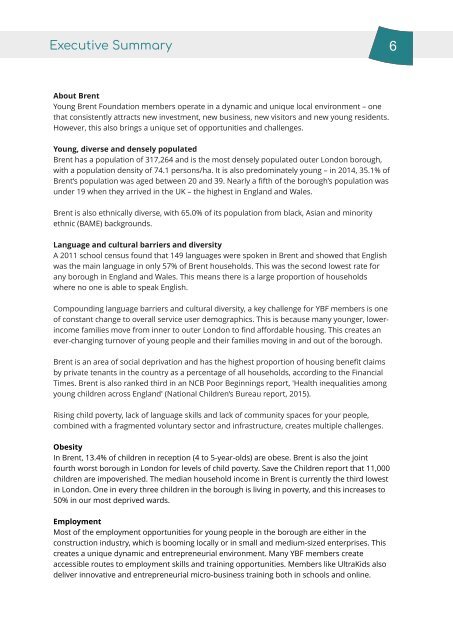Young Brent Survey
You also want an ePaper? Increase the reach of your titles
YUMPU automatically turns print PDFs into web optimized ePapers that Google loves.
Executive Summary<br />
6<br />
About <strong>Brent</strong><br />
<strong>Young</strong> <strong>Brent</strong> Foundation members operate in a dynamic and unique local environment – one<br />
that consistently attracts new investment, new business, new visitors and new young residents.<br />
However, this also brings a unique set of opportunities and challenges.<br />
<strong>Young</strong>, diverse and densely populated<br />
<strong>Brent</strong> has a population of 317,264 and is the most densely populated outer London borough,<br />
with a population density of 74.1 persons/ha. It is also predominately young – in 2014, 35.1% of<br />
<strong>Brent</strong>’s population was aged between 20 and 39. Nearly a fifth of the borough’s population was<br />
under 19 when they arrived in the UK – the highest in England and Wales.<br />
<strong>Brent</strong> is also ethnically diverse, with 65.0% of its population from black, Asian and minority<br />
ethnic (BAME) backgrounds.<br />
Language and cultural barriers and diversity<br />
A2011schoolcensusfoundthat149languageswerespokenin<strong>Brent</strong>andshowedthatEnglish<br />
was the main language in only 57% of <strong>Brent</strong> households. This was the second lowest rate for<br />
any borough in England and Wales. This means there is a large proportion of households<br />
where no one is able to speak English.<br />
Compounding language barriers and cultural diversity, a key challenge for YBF members is one<br />
of constant change to overall service user demographics. This is because many younger, lowerincome<br />
families move from inner to outer London to find affordable housing. This creates an<br />
ever-changing turnover of young people and their families moving in and out of the borough.<br />
<strong>Brent</strong> is an area of social deprivation and has the highest proportion of housing benefit claims<br />
by private tenants in the country as a percentage of all households, according to the Financial<br />
Times. <strong>Brent</strong> is also ranked third in an NCB Poor Beginnings report, 'Health inequalities among<br />
young children across England' (National Children’s Bureau report, 2015).<br />
Rising child poverty, lack of language skills and lack of community spaces for your people,<br />
combined with a fragmented voluntary sector and infrastructure, creates multiple challenges.<br />
Obesity<br />
In <strong>Brent</strong>, 13.4% of children in reception (4 to 5-year-olds) are obese. <strong>Brent</strong> is also the joint<br />
fourth worst borough in London for levels of child poverty. Save the Children report that 11,000<br />
children are impoverished. The median household income in <strong>Brent</strong> is currently the third lowest<br />
in London. One in every three children in the borough is living in poverty, and this increases to<br />
50% in our most deprived wards.<br />
Employment<br />
Most of the employment opportunities for young people in the borough are either in the<br />
construction industry, which is booming locally or in small and medium-sized enterprises. This<br />
creates a unique dynamic and entrepreneurial environment. Many YBF members create<br />
accessible routes to employment skills and training opportunities. Members like UltraKids also<br />
deliver innovative and entrepreneurial micro-business training both in schools and online.





